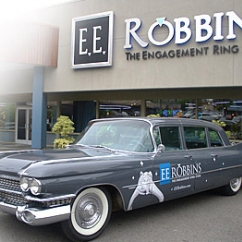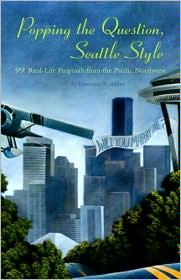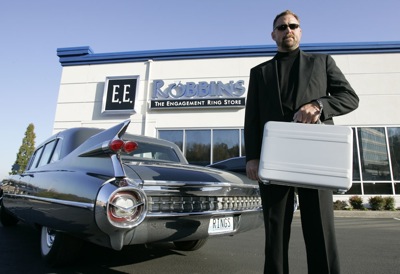Articles and News
EE ROBBINS: ALL BRIDAL, ALL THE TIME EQUALS SUCCESS | May 02, 2012 (1 comment)

This is the second in a series about prestige jewelers who do well in the bridal category. Look for more in the upcoming weeks, and a special new Centurion PDF Book devoted to bridal, to be published and available in mid-May.
Seattle, WA--There’s absolutely no doubt from the EE Robbins website or the EE Robbins Facebook page that this company is all about bridal—or at least, about 99% bridal. Emerson “Skip” Robbins, founder of the two-story chain in Seattle and Bellevue, WA, calls it “maybe the most niched jewelry store in the world.” The stores do carry a small amount of non-bridal jewelry, but even those are mostly stud earrings and wedding day type of bridal items.
Robbins has no title on his business card, although he founded the stores in 1999 and 2002, respectively. He did have a third store for a while, in Tacoma, but the outlying areas around Seattle could not support it and it was sold in 2011. He and his close-knit staff all wear multiple hats: one store manager is also the diamond buyer, the controller also is the IT guy, and one of his buyers also is a good portion of the marketing department. Robbins will admit to being the “Big Cheese” from time to time, even without a formal title.
EE Robbins has a number of awards and recognitions, including being named Best of Seattle for engagement and wedding rings for the past seven years, as voted on by Seattle Bride magazine, and for the past four years, being voted “BEST Rings of Western Washington” by local NBC-TV affiliate KING 5, for the past four years.
The merchandise mix. When EE Robbins first opened, inventory was largely made up of designer bridal lines. Initially that worked very well, but Robbins found over time that the designers didn’t or couldn’t always keep their word on exclusivity. As Robbins felt a woman should never go to the grocery store or go to work and see another woman with the same ring on, that exclusivity was important. He did get exclusivity from some vendors, but if he did not or if the firm lost its exclusive, he retired the vendor.
When the recession hit in late 2007, Robbins said they started getting resistance to [the price of] designer lines. And not just in the jewelry business, he observed. In many businesses, the word “designer” became code for “overpriced,” he said.
“And many times they were right,” Robbins says bluntly. “At that point, we decided to design and manufacture our own merchandise. The more traditional jewelry we did ourselves. The more boutique [designer] lines and those lines with stronger relationships to the designer, we kept those. You can’t have the depth of styling and do it all yourself.” The firm manufactures in the United States.
While many jewelers have turned to off the street buying as a way to boost margins, EE Robbins sells mostly new inventory, at least for its larger stones. “We take our own diamonds back as trade-ins,” says Robbins. “Only a few outside diamonds make our standards. We do try and buy diamonds off the street, but only about 10% meet our quality standards. We’re very selective. Our buyer goes overseas, to Tel Aviv and Canada and buys.”
The customer. When asked “who is your bridal customer,” Robbins’ answer is simple: “In reality, it’s everyone. When you’re marketing, you have to focus.” Robbins’ focus is on the most prevalent bridal age group, which used to be 18-25 years of age but now is 25-34. He uses those breakdowns as they match advertising demographics.
Robbins also markets to the gay population. “We believe that love comes in different forms,” he says. Robbins words his radio ads so they don’t mention him or her or he/she; instead they focus on the couple. There’s a lesbian couple featured on his EE Couples website. A sister site to the EE Robbins site, it features stories of couples that have become engaged through EE Robbins.
The Internet as competition. Robbins has a methodology of working with the customer who has started the diamond search on the Web: “We tell them, if you really care, you need to see the diamonds and compare them. Almost any diamond will look good by itself, but put it next to a really beautiful one and it doesn’t look as good.” It’s like looking at white paint chips, he says: they all look white until they are next to each other, then it’s easy to see that one is pinkish white while another is yellowish white, and so forth.
“It’s the same with diamonds,” he says.
Extreme marketing. “If you want to be successful in business, you have to take a path different than your competitors. Lots of different niches are successful,” says Robbins. In addition to creating a niche as an all-bridal jewelry store, Robbins also has carved out a niche for his creative marketing, which has been very successful.

An EE Robbins billboard takes a playful riff on an old motel "Vacancy" sign, in this case, the ring finger.
“With technological changes now occurring at hyper-speed, we can no longer advertise and market the way we used to. The influence of the Internet and the impact of cell and smart phones has been absolutely world-shaking in changing customers habits,” said Robbins. “Every major media has been fragmented. It’s impossible to get a strong reach and frequency in mid-size market and a normal budget.” Robbins found a way for his business around those issues.
“We do radio and little niche things that get attention,” says Robbins. His comprehensive list of ‘little things’ is well detailed on the EE Robbins website. He’s made an art of creatively engaging his customers. A few samples:
Popping the question, Seattle style. Robbins published a book about five years ago titled Popping the Question Seattle Style. He ran a contest for the most romantic and creative proposals. The winner received a trip to Hawaii and a $10,000 shopping spree. He chose the best 99 stories for the book. It’s free to shoppers today and is still sold locally in Barnes & Noble and copies are also available on Amazon.

The “Proposer.” From the EE Robbins website: “No, he won't do the proposing for you. As a free service to our customers, this impressive gentleman will bring your ring to your pre-determined Seattle-area location at the precise moment you're ready to propose. Dressed in a sharp black suit, The Proposer will arrive in a smoke-grey 1959 Cadillac limousine, transport your ring in a steel briefcase handcuffed securely to his wrist, open the steel briefcase and simply hand you the ring with a cordial ‘Here's your delivery,’ then disappear faster than she can say, ‘YES.’ It'll definitely grab her attention. The rest is up to you.”
The Proposer with the EE limo, a rare 1959 Cadillac--fins and all--whose license plate reads "RINGS."
The Proposer stays busy. According to Robbins, he is booked three or four times each month. The history of The Proposer at Robbins has had its ups and downs. Initially Robbins ran ads on Craig’s list to find the right person; i.e, someone nice looking with a pleasing personality, who could drive safely and be trusted with an engagement ring. They couldn’t seem to find that combination. Then Robbins’ wife, Sherri, was shopping at a local Whole Foods market and thought the guy behind the meat counter would be perfect. He wrote his name and number on meat wrapping and became the first Proposer. But even he wasn’t without problems: apparently he was too good looking, which was a bit intimidating for the guy who was proposing. So, when he left, he was replaced with the ‘regular-looking’ limo guys, who now go out on the calls.
The EE limousine. The EE limo, a rare 1959 Cadillac with a license plate that reads, “RINGS,” is often seen around the Seattle area. It’s available for loan for a customer’s proposal or wedding, and also is often seen being driven by The Proposer. It's shown with the Proposer and also at the top of this article.
“Do things that are different,” says Robbins. “The same old thing doesn’t get attention.” This philosophy seems to embody his whole approach. The same old thing indeed!
The Attitude. “We treat people [customers] with the golden rule,” says Robbins. “We don’t use sales trainers; we just do not believe in manipulative selling. Instead, we educate the customer and trust they then make the decision that’s best for them. Karma driven, that’s how we run our business.”
“We inform. We don’t sell. We educate,” he concludes.
The EE Robbins Back Story
How the bridal store, EE Robbins, came about is an interesting story. In the late 1980’s, Robbins and his brother, Steve Robbins, had 14 mall stores, all doing pretty well. Today they're in separate businesses.
When they started, most malls had only a few [jewelry] stores. The brothers marketed using mainly direct mail. But by the early to mid-1980’s, malls began to see profits in jewelers and some malls would have 20-25 jewelers—all using direct mail.
“Soon, customers would come to mall [jewelry] stores and were not even sure which store they were in,” said Robbins. Sales volumes were leveling out, and the brothers’ stores were no longer always the sales leaders in their respective malls.
So the brothers decided create a complete engagement ring store. They traveled the United States to see better bridal stores. “Everyone in the industry thought we’d lost our brains,” said Robbins. In 1991 they ran a complete liquidation of the company and changed everything: the name, the marketing, the inventory, etc. They packed their stores with engagement rings and changed their marketing from direct mail to using only radio.
Their idea worked to a degree. The revamped stores did OK. But while they found they were bringing in shoppers, those same customers felt they needed to shop all the [jewelry] stores in the mall. Then they opened Robbins Brothers, a non-mall destination store in Fullerton, CA. Business there immediately took off; it doubled what their mall stores had done in the first year.
“We said WOW,” said Robbins. “We sold our mall stores as fast as we could, opening super-destination stores. Wedding and anniversary rings, too, along with engagement rings.”
Of the two brothers, Skip Robbins was the marketing and merchandising guy. His brother Steve was operations and finance. They worked well together. “Steve was the hardest working guy I ever met,” said Robbins. Robbins wrote the now iconic Southern California radio ads touting “Skip and Steve” at Robbins Brothers. A little kitschy, the ads gave the stores personality and sales soared.
The Robbins Brothers stores had very healthy sales from the start, thanks to the brothers. But their approaches differed. Skip Robbins was more of an entrepreneur and did not enjoy the corporate structure. Born in Seattle, he loved the Northwest. His kids were getting out of high school and he wanted to open his ‘dream store.’ He told his brother he wanted out, retained a minority interest, and had enough to open that dream store. The rest is history, but the brothers are still close today, talking three or four times a week, says Robbins.








